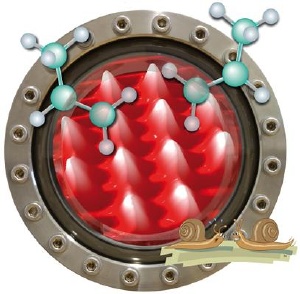May 29 2009
Catalysts do function, despite the fact that not all the chemical reactions (and partial reactions) which occur are fully understood, including those which take place during the treatment of automobile exhaust. If scientists understood these processes better not only would they be able to optimize exhaust gas catalysts but also other phenomena which are observed on surfaces, for instance when molecules orient themselves in either right or left handed fashion (i.e. as an image or mirror image). Knowing this would, not least, open new avenues of development in pharmacology for the manufacturers of medicines.
 Two molecules which possess mirror image symmetry, like snail shells.
Two molecules which possess mirror image symmetry, like snail shells.
“We tickle molecules,” is how Karl-Heinz Ernst of Empa’s Nanoscale Materials Science Laboratory describes the experiments that he and his colleagues perform to investigate the chemical reactions which take place on surfaces. Using the electron beam of a scanning tunnel microscope (STM), they induce individual molecules to resonate at very precise frequencies. This is possible because the STM is not just a microscope, capable of imaging the tiniest particles, but also an extremely sensitive tool which can be used to manipulate single atoms and molecules.
During their experiments the Empa scientists observed that the excited molecules began to hop about and move around, rotating about their own axes. They also underwent very rapid “inversion”, that is, flipping over into their mirror image shape. By changing the electrical voltage and the tunnel current in the STM the researchers were able to identify which parts of the molecule became excited and how they reacted.
Pairs which are nearly – but not quite – identical
Ernst and his colleagues are particularly interested in this mirror-image or chiral behavior. Such mirror-image pairs, which appear alike but are still different, occur quite frequently in nature, and one may rotate and turn them any way possible in a vain attempt to prove them identical. Prime examples of chirality are snail shells, certain minerals and – yes – molecules. Many molecules which are essential to life have mirror-image forms, for example DNA, proteins (and their building block components, the amino acids), and sugars.
These molecules occur almost exclusively in one of the mirror image forms. Why this is so remains a puzzle with far reaching consequences, because the two forms of a chiral molecule can have completely different biological effects, despite possessing identical physical and chemical properties. The perfume Carvon, for instance, smells of mint or cumin depending on whether it is the left or right handed version. Less trivial were the effects of the soporific drug Contergan used in the 60’s. The right handed form of its active ingredient, thalidomide, caused the desired effect of sleepiness, but when taken by expectant mothers the left handed version of the drug caused severe congenital malformations in their babies.
If these experiments can now be better modeled and as a result the researchers discover why molecules jump over into their mirror image form, the result would be new synthesis processes of benefit not just to the pharmacological world.